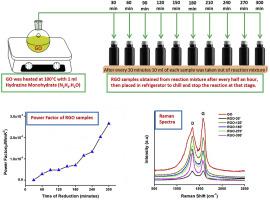当前位置:
X-MOL 学术
›
Mater. Chem. Phys.
›
论文详情
Our official English website, www.x-mol.net, welcomes your
feedback! (Note: you will need to create a separate account there.)
Facile chemical tuning of thermoelectric power factor of graphene oxide
Materials Chemistry and Physics ( IF 4.3 ) Pub Date : 2020-11-01 , DOI: 10.1016/j.matchemphys.2020.123488 Tariq Mehmood , Jin Ho Kim , Do-Joong Lee , Sergey Dizhur , Rachel Odessey , Elizabeth S. Hirst , Richard M. Osgood , Muhammad Hassan Sayyad , Munawar Ali Munawar , Jimmy Xu
Materials Chemistry and Physics ( IF 4.3 ) Pub Date : 2020-11-01 , DOI: 10.1016/j.matchemphys.2020.123488 Tariq Mehmood , Jin Ho Kim , Do-Joong Lee , Sergey Dizhur , Rachel Odessey , Elizabeth S. Hirst , Richard M. Osgood , Muhammad Hassan Sayyad , Munawar Ali Munawar , Jimmy Xu

|
Abstract Reduced graphene oxide (RGO) is known for its excellent mechanical, electrical, thermal, and optical properties and is a promising material for high efficiency thermoelectrics. Given that graphene oxidation turns a metallic graphene into semiconductor and degree of oxidation can be controlled chemically, it is hypothesized that thermoelectric performance of RGO may be tailored by its degree of reduction. This points to a potential avenue for optimizing the thermoelectric efficiency of RGO, because both its Seebeck coefficient and electrical conductivity is dependent on its band gap which is manageable. This report presents an investigation of such effects where pristine graphene oxide (GO) was reduced by hydrazine monohydrate and the degree of reduction was carefully controlled by reduction time. Raman spectroscopy, UV–visible spectroscopy and FTIR spectrometry were used for the characterization of GO and RGO samples. While the pristine GO showed a very low D/G intensity ratio in Raman spectra and was poorly conducting electrically, the time-controlled reductions successively improved the D/G intensity ratio, the Seebeck coefficient and electrical conductivity of the RGO samples. Depending on the reduction time we found that the Seebeck coefficient of the RGO can increase from 12.91 μV/K to 24.3 μV/K, electrical conductivity from 0.0084 S/m to 19.9 S/m and thermoelectric power factor from 1.40 × 10−6 μW/mK2 to 2.65 × 10−3 μW/mK2 respectively.
中文翻译:

氧化石墨烯热电功率因数的简便化学调谐
摘要 还原氧化石墨烯 (RGO) 以其优异的机械、电学、热学和光学性能而闻名,是一种很有前途的高效热电材料。鉴于石墨烯氧化将金属石墨烯转化为半导体,并且可以通过化学方式控制氧化程度,因此假设 RGO 的热电性能可以通过其还原程度来调整。这指出了优化 RGO 热电效率的潜在途径,因为其塞贝克系数和电导率都取决于其可控的带隙。本报告介绍了这种影响的研究,其中原始氧化石墨烯 (GO) 被一水合肼还原,还原程度通过还原时间仔细控制。拉曼光谱,紫外-可见光谱和 FTIR 光谱用于表征 GO 和 RGO 样品。虽然原始 GO 在拉曼光谱中显示出非常低的 D/G 强度比并且导电性差,但时间控制的减少连续提高了 RGO 样品的 D/G 强度比、塞贝克系数和电导率。根据还原时间,我们发现 RGO 的塞贝克系数可以从 12.91 μV/K 增加到 24.3 μV/K,电导率从 0.0084 S/m 增加到 19.9 S/m,热电功率因数从 1.40 × 10−6 μW /mK2 分别为 2.65 × 10−3 μW/mK2。时间控制的还原连续提高了 RGO 样品的 D/G 强度比、塞贝克系数和电导率。根据还原时间,我们发现 RGO 的塞贝克系数可以从 12.91 μV/K 增加到 24.3 μV/K,电导率从 0.0084 S/m 增加到 19.9 S/m,热电功率因数从 1.40 × 10−6 μW /mK2 分别为 2.65 × 10−3 μW/mK2。时间控制的还原连续提高了 RGO 样品的 D/G 强度比、塞贝克系数和电导率。根据还原时间,我们发现 RGO 的塞贝克系数可以从 12.91 μV/K 增加到 24.3 μV/K,电导率从 0.0084 S/m 增加到 19.9 S/m,热电功率因数从 1.40 × 10−6 μW /mK2 分别为 2.65 × 10−3 μW/mK2。
更新日期:2020-11-01
中文翻译:

氧化石墨烯热电功率因数的简便化学调谐
摘要 还原氧化石墨烯 (RGO) 以其优异的机械、电学、热学和光学性能而闻名,是一种很有前途的高效热电材料。鉴于石墨烯氧化将金属石墨烯转化为半导体,并且可以通过化学方式控制氧化程度,因此假设 RGO 的热电性能可以通过其还原程度来调整。这指出了优化 RGO 热电效率的潜在途径,因为其塞贝克系数和电导率都取决于其可控的带隙。本报告介绍了这种影响的研究,其中原始氧化石墨烯 (GO) 被一水合肼还原,还原程度通过还原时间仔细控制。拉曼光谱,紫外-可见光谱和 FTIR 光谱用于表征 GO 和 RGO 样品。虽然原始 GO 在拉曼光谱中显示出非常低的 D/G 强度比并且导电性差,但时间控制的减少连续提高了 RGO 样品的 D/G 强度比、塞贝克系数和电导率。根据还原时间,我们发现 RGO 的塞贝克系数可以从 12.91 μV/K 增加到 24.3 μV/K,电导率从 0.0084 S/m 增加到 19.9 S/m,热电功率因数从 1.40 × 10−6 μW /mK2 分别为 2.65 × 10−3 μW/mK2。时间控制的还原连续提高了 RGO 样品的 D/G 强度比、塞贝克系数和电导率。根据还原时间,我们发现 RGO 的塞贝克系数可以从 12.91 μV/K 增加到 24.3 μV/K,电导率从 0.0084 S/m 增加到 19.9 S/m,热电功率因数从 1.40 × 10−6 μW /mK2 分别为 2.65 × 10−3 μW/mK2。时间控制的还原连续提高了 RGO 样品的 D/G 强度比、塞贝克系数和电导率。根据还原时间,我们发现 RGO 的塞贝克系数可以从 12.91 μV/K 增加到 24.3 μV/K,电导率从 0.0084 S/m 增加到 19.9 S/m,热电功率因数从 1.40 × 10−6 μW /mK2 分别为 2.65 × 10−3 μW/mK2。











































 京公网安备 11010802027423号
京公网安备 11010802027423号